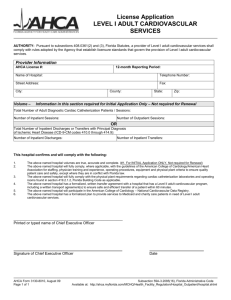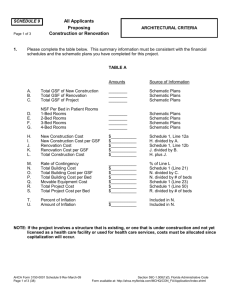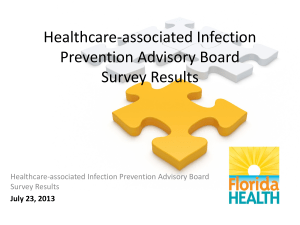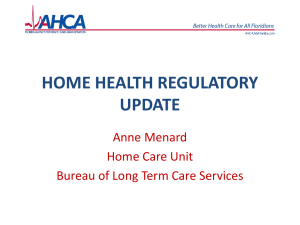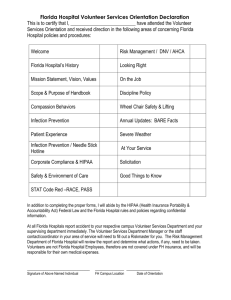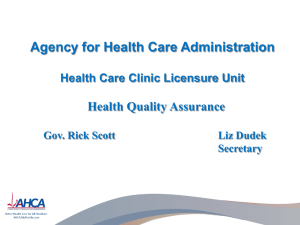Home Health Agencies - Agency for Health Care Administration
advertisement
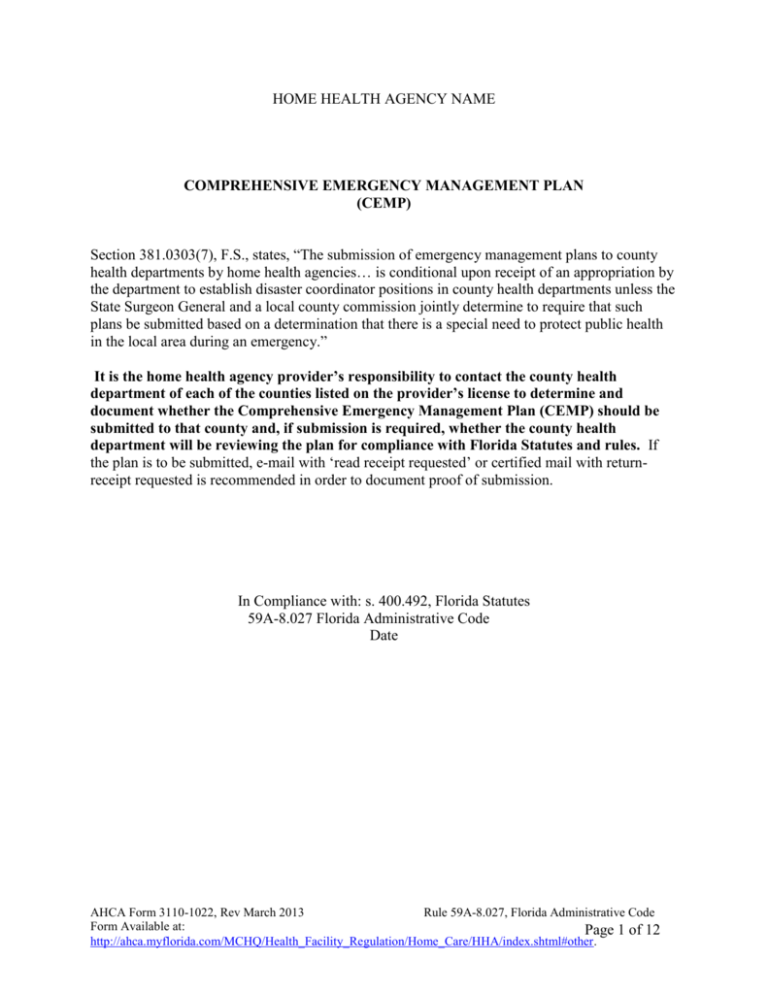
HOME HEALTH AGENCY NAME COMPREHENSIVE EMERGENCY MANAGEMENT PLAN (CEMP) Section 381.0303(7), F.S., states, “The submission of emergency management plans to county health departments by home health agencies… is conditional upon receipt of an appropriation by the department to establish disaster coordinator positions in county health departments unless the State Surgeon General and a local county commission jointly determine to require that such plans be submitted based on a determination that there is a special need to protect public health in the local area during an emergency.” It is the home health agency provider’s responsibility to contact the county health department of each of the counties listed on the provider’s license to determine and document whether the Comprehensive Emergency Management Plan (CEMP) should be submitted to that county and, if submission is required, whether the county health department will be reviewing the plan for compliance with Florida Statutes and rules. If the plan is to be submitted, e-mail with ‘read receipt requested’ or certified mail with returnreceipt requested is recommended in order to document proof of submission. In Compliance with: s. 400.492, Florida Statutes 59A-8.027 Florida Administrative Code Date AHCA Form 3110-1022, Rev March 2013 Rule 59A-8.027, Florida Administrative Code Form Available at: Page 1 of 12 http://ahca.myflorida.com/MCHQ/Health_Facility_Regulation/Home_Care/HHA/index.shtml#other. Table of Contents Page # I. INTRODUCTION ______ II. CONCEPT OF OPERATIONS A. Direction and Control B. Education of Patients Prior to an Emergency C. Notification D. During an Emergency E. Evacuation F. The Patients Return Home ______ ______ ______ ______ ______ ______ III. INFORMATION, TRAINING AND EXERCISE ______ IV. APPENDICES A. Agreements and Understandings B. Information for Home Health Patients C. Support Material ______ ______ ______ ______ Create Additional Appendices as Appropriate. Instructions: Answer each of the items directly on the form. Once it is completed please e-mail it to the comprehensive emergency management plan (CEMP) reviewer for your county or multicounty area. If any changes are needed, the reviewer will send comments to your home health agency via e-mail or through regular mail with a due date for corrections to be forwarded back to the reviewer. The CEMP reviewer for your area is listed at our website at http://ahca.myflorida.com/licensing_cert.shtml. . Click on “Home Health Agency” Look under Emergency Management Plan for the Emergency Management Plan Review Contacts... The CEMP reviewer will let you know when your plan is approved. Remember to update the plan on an annual basis and/or as needed. AHCA Form 3110-1022, Rev March 2013 Rule 59A-8.027, Florida Administrative Code Form Available at: Page 2 of 12 http://ahca.myflorida.com/MCHQ/Health_Facility_Regulation/Home_Care/HHA/index.shtml#other. I. INTRODUCTION Insert any appropriate introductory or overview remarks. 1. Basic Information about the Home Health Agency Home Health Agency Name: Address: Phone Number: Fax Number: County (ies) Licensed in: 2. Person in Charge during Emergency (Key Staff) Primary Name/Title (Safety Liaison) Home Phone Number: Work Phone Number: Pager Number: Cell Phone Number: Alternate Name/Title: Home Phone Number: Work Phone Number: Pager Number: Cell Phone Number: Insert additional alternates as appropriate. 3. Home Health Agency Owner(s) Name/Title: Address: Work Phone Number: Home Phone Number: Pager Number: Cell Phone Number: Insert additional owners as appropriate. AHCA Form 3110-1022, Rev March 2013 Rule 59A-8.027, Florida Administrative Code Form Available at: Page 3 of 12 http://ahca.myflorida.com/MCHQ/Health_Facility_Regulation/Home_Care/HHA/index.shtml#other. 4. Person(s) Who Developed Plan Name/Title: Address: Work Phone Number: Home Phone Number: Insert additional planners as appropriate. II. CONCEPT OF OPERATIONS Please provide responses describing how the home health agency will provide the following: A. Direction and Control 1. The chain of command for ensuring continuous leadership and authority in key positions: 2. The procedures for ensuring timely activation of the home health agency’s emergency management plan and staffing of the home health agency during an emergency: 3. The operational and support roles of all those home health agency staff that are designated to be involved in emergency measures: 4. The management of patients in private homes, assisted living facilities (ALF) and adult family care homes (AFCH) who will continue to receive services by the home health agency during an emergency: B. Education of Patients Prior to an Emergency 1. The procedures for educating patients or patients’ caregivers at the onset of care and as needed about the home health agency’s emergency management plan: 2. The procedures for discussing with those patients in private homes, ALFs and AFCHs who need continued services, who are not registered with the special needs registry, the patients’ plan during, and immediately following, an emergency and contacting the ALF and/or AFCH for patients served by the home health agency regarding the plan for the patient during, and immediately following, an emergency: AHCA Form 3110-1022, Rev March 2013 Rule 59A-8.027, Florida Administrative Code Form Available at: Page 4 of 12 http://ahca.myflorida.com/MCHQ/Health_Facility_Regulation/Home_Care/HHA/index.shtml#other. 3. The procedures for discussing the special needs registry with those patients who will require evacuation to a special needs shelter during an emergency: 4. The home health agency’s procedures for collecting and submitting patient registration information for the special needs registry, (pursuant to 59A-8.027(13), F.A.C.), which must be done prior to an emergency, not when an emergency is approaching or occurring: 5. The education of patients regarding their responsibility for their medication, supplies and equipment list or other emergency preparedness information as needed (in accordance with Appendix B, Section 2): 6. The education of patients registered with the special needs registry on the information contained in Appendix B as well as the limitation of services and conditions in a shelter; that the level of services will not equal what they receive at home; that conditions in the shelter may be stressful and may even be inadequate for their needs; and that the special needs shelters are an option of last resort: C. Notification 1. The procedures on how the home health agency staff in charge of emergency plan implementation will receive warnings of emergency situations, including off hours, weekends and holidays: 2. For home health agencies that provide skilled care, list the home health agency’s 24-hour contact number, if different than the number listed in the introduction: 3. The procedures for alerting key staff: 4. The policies and procedures for reporting to work for key workers, when the home health agency remains operational: 5. The procedures to confirm plans and alert patients in private homes, ALFs and/or AFCHs where patients are served and the precautionary measures that will be taken including but not limited to the home health agency’s inability to operate due to situations that are beyond their control. (Refer to s. 400. 492(3), F.S., for a description of how a home health agency shall demonstrate a good faith effort to comply with their emergency management plan): AHCA Form 3110-1022, Rev March 2013 Rule 59A-8.027, Florida Administrative Code Form Available at: Page 5 of 12 http://ahca.myflorida.com/MCHQ/Health_Facility_Regulation/Home_Care/HHA/index.shtml#other. 6. The procedures for alternative means of notification of key staff and communicating with the local county health department and county emergency management should the primary system fail (pursuant to s. 400.492, F.S.): 7. The procedures for maintaining a current prioritized list of patients who need continued services during an emergency in the home, ALFs and AFCHs. The list shall indicate how services shall be continued in the event of an emergency or disaster for each patient and if the patient is to be transported to a special needs shelter, and shall indicate if the patient is receiving skilled nursing services and the patient’s medication and equipment needs. The list shall be furnished to county health departments and to local emergency management agencies, upon request (pursuant to s. 400.492 (2), F.S.): D. During an Emergency 1. When there is not a mandatory evacuation, some patients may decide to stay in their homes, ALF or AFCH. Describe the procedures the home health agency will take to assure that all patients needing continuing care will receive it, either from the home health agency or through arrangements made by the patient or the patient’s caregiver; and how the home health agency will ensure that nursing personnel continue essential services such as insulin and other injections to patients in ALFs and/or AFCHs: 2. Identify the procedures for the home health agency to assure that all patients in homes, ALFs and /or AFCHs needing continuing care will receive it, either from the home health agency, through a special needs shelter, or through arrangements made by the patient or the patient’s caregiver, ALF or AFCH: Include the means by which the home health agency will continue to provide the same type and quantity of services to its patients who evacuate to special needs shelters that were being provided to those patients prior to evacuation per s. 400.492, F.S. 3. Identify the procedures for ceasing operation, (as defined in s.400.492, F.S.), including notifying all patients or patient caregivers that the home health agency is ceasing operations: E. Evacuation 1. The procedures for establishing, and keeping updated medication, supplies and equipment lists, (as defined in 59A-8.027, F.A.C.), to be kept in the homes of special needs patients and to accompany the patient during evacuation to a special needs shelter: 2. The procedures for educating the patient and caregiver concerning the medication, supplies and equipment list, (as defined in appendix B of this document), and the need for this list and other items to accompany the patient during the evacuation: AHCA Form 3110-1022, Rev March 2013 Rule 59A-8.027, Florida Administrative Code Form Available at: Page 6 of 12 http://ahca.myflorida.com/MCHQ/Health_Facility_Regulation/Home_Care/HHA/index.shtml#other. 3. The resources necessary to continue essential care or services or make referrals to other organizations subject to written agreement which include how the home health agency will continue to provide care to ALF and/or AFCH patients who relocate in the same geographic service area or relocate outside the geographic service area : 4. The procedures for contacting the emergency operation center after the disaster to report on the home health agency’s damage, if any, and their availability to continue services to their patients in the special needs shelter: F. The Patients Return Home 1. The procedures on how the home health agency will re-establish contact with patients in the patients’ home, ALF and AFCH and resume patient care: 2. The procedures on how the home health agency will re-establish contact with employees and re-start patient care: 3. The procedures on how the home health agency will provide or arrange for prioritizing care should the emergency result in less staff being available immediately following the disaster: III. INFORMATION, TRAINING AND EXERCISE Insert any appropriate introductory or overview remarks. Please provide responses describing how the home health agency will provide the following: 1. The procedures on how key workers will be instructed, prior to an emergency, in their roles and responsibilities during an emergency: 2. The procedures for developing a training schedule for all employees and identification of who will provide the training. Training will include a definition of what constitutes an emergency, when the emergency management plan will go into effect, the roles and responsibilities of essential and non-essential staff, the procedures for educating patients about the emergency management plan and the special needs registry. The training will also include information for staff on how they can work, if they choose to do so, with the local state or county agency who will be managing and staffing the special needs shelter during an emergency (pursuant to s. 456.38, F.S., and s. 381.0303, F.S.): 3. The home health agency’s provisions for training new employees regarding their disaster related roles and responsibilities: AHCA Form 3110-1022, Rev March 2013 Rule 59A-8.027, Florida Administrative Code Form Available at: Page 7 of 12 http://ahca.myflorida.com/MCHQ/Health_Facility_Regulation/Home_Care/HHA/index.shtml#other. IV. APPENDICES The appendices that follow are provided in support of the home health agency’s comprehensive emergency management plan. AHCA Form 3110-1022, Rev March 2013 Rule 59A-8.027, Florida Administrative Code Form Available at: Page 8 of 12 http://ahca.myflorida.com/MCHQ/Health_Facility_Regulation/Home_Care/HHA/index.shtml#other. APPENDIX A: AGREEMENTS AND UNDERSTANDINGS List on this page and insert copies on following pages, and include annual update mutual agreements, memoranda of understanding, or any other understandings entered into between the home health agency and any local, state, and county entities, or health care entities, and service providers that have responsibility during a disaster. This is to include current agreements needed to ensure the operational integrity of the plan. AHCA Form 3110-1022, Rev March 2013 Rule 59A-8.027, Florida Administrative Code Form Available at: Page 9 of 12 http://ahca.myflorida.com/MCHQ/Health_Facility_Regulation/Home_Care/HHA/index.shtml#other. APPENDIX B: INFORMATION FOR HOME HEALTH PATIENTS Insert copy on next page AHCA Form 3110-1022, Rev March 2013 Rule 59A-8.027, Florida Administrative Code Form Available at: Page 10 of 12 http://ahca.myflorida.com/MCHQ/Health_Facility_Regulation/Home_Care/HHA/index.shtml#other. APPENDIX B: INFORMATION FOR HOME HEALTH AGENCY PATIENTS The following information should be supplied by the home health agency to those patients registered with the special needs registry, so they will be prepared prior to an evacuation to a special needs shelter. Please note: The special needs shelter should be used as a place of last refuge. The evacuee may not receive the same level of care received from staff in the home, and the conditions in a shelter might be stressful. (1) If the patient has a caregiver1, the caregiver must accompany the patient and must remain with the patient at the special needs shelter. (2) The following is a list of what special needs patients need to bring with them to the special needs shelter during an evacuation: Bed sheets, blankets, pillow, folding lawn chair, air mattress The patient’s medication, supplies and equipment list supplied by the home health agency, including the phone, beeper and emergency numbers for the patient’s physician, pharmacy and, if applicable, oxygen supplier; supplies and medical equipment for the patient’s care; Do Not Resuscitate (DNRO) form, if applicable; Name and phone number of the patient’s home health agency Prescription and non-prescription medication needed for at least 72 hours; oxygen for 72 hours, if needed. A copy of the patient’s plan of care Identification and current address Special diet items, non-perishable food for 72 hours and 1 gallon of water per person per day Glasses, hearing aides and batteries, prosthetics and any other assistive devices Personal hygiene items for 72 hours Extra clothing for 72 hours Flashlight and batteries Self-entertainment and recreational items, like books, magazines, quiet games. (3) Shelterees need to know the following: If the patient has a caregiver, the caregiver(s) shall be allowed to shelter together in the special needs shelter. If the person with special needs is responsible for the care of individuals without special needs, those persons may also shelter together. The shelteree caregiver will have floor space provided. The caregiver must provide his or her own bedding. Service dogs are allowed in the shelter. However, check with your local Emergency Management office to see if other pets are permitted. Bring personal snacks, drinks, and any special dietary foods for 72 hours. It is possible only sparse meals will be provided. Caregivers who regularly assist the patient in the home are expected to continue to do the same care in the shelter. . 1 Caregivers can be relatives, household members, guardians, friends, neighbors and volunteers. AHCA Form 3110-1022, Rev March 2013 Rule 59A-8.027, Florida Administrative Code Form Available at: Page 11 of 12 http://ahca.myflorida.com/MCHQ/Health_Facility_Regulation/Home_Care/HHA/index.shtml#other. APPENDIX C: SUPPORT MATERIAL List on this page and insert copies on following pages. AHCA Form 3110-1022, Rev March 2013 Rule 59A-8.027, Florida Administrative Code Form Available at: Page 12 of 12 http://ahca.myflorida.com/MCHQ/Health_Facility_Regulation/Home_Care/HHA/index.shtml#other.
